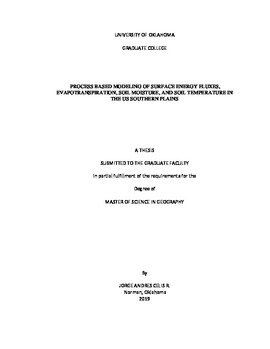| dc.contributor.advisor | Moreno, Hernan A. | |
| dc.contributor.author | Celis, Jorge Andres | |
| dc.date.accessioned | 2019-12-16T16:14:48Z | |
| dc.date.available | 2019-12-16T16:14:48Z | |
| dc.date.issued | 2019-12-13 | |
| dc.identifier.uri | https://hdl.handle.net/11244/323239 | |
| dc.description.abstract | This study aims to evaluate the capability and transferability of a physically-based hydrologic model to understand the trade-offs between precipitation, soil moisture and surface energy fluxes at sites with different vegetation types in the U.S. Southern Plains. One of the benefits of training a process-based model is the capacity to use it as a complement to standard weather stations for predicting energy fluxes, soil temperature and moisture estimations.
Modeling of the terrestrial surface soil moisture and temperature, and boundary layer energy fluxes is key for understanding the spatio-temporal variability of hydro-meteorological conditions that drive normal and extreme (i.e. floods and droughts) events. Soil moisture (SM), surface energy fluxes (SEF) and soil temperatures (ST) play an important role in the ground and near surface hydro-energetic dynamics, especially in water exchange processes such as the evapotranspiration (ET). ET is an important variable for understanding the energy, water and biogeochemical budgets.
This study uses the Triangulated Irregular Network TIN-based Real Time Integrated Basin Simulator (tRIBS), a continuous physically-based distributed hydrological model, to provide estimations of the surface energy balance (SEB) components in typical environments of the U.S. Southern Plains. Both calibration and validation of the model are performed using available Eddy Covariance Tower (ECT) observations distributed on crops and grasslands in Oklahoma. The model calibration is based on a hybrid strategy that uses a manual procedure followed by an optimization algorithm based on the Shuffled Complex Evolution (SCE) theory. All data used to parametrize the model is free-access. Satellite data is needed to represent dynamic vegetation conditions of albedo, leaf area index, vegetation throughfall coefficient, stomatal resistance and vegetation fraction. Model calibration is conducted during one hydrologic year at two stations with differing vegetation cover. Model validation is conducted at the same ECTs during a different year than the calibration. Transferability of the model parameterization is tested at other ECT with similar vegetation conditions in the Southern Plains. The model calibration and validation results showed the strong capabilities of tRIBS to predict the energy fluxes (Nash>0.5) and the soil temperature profile (Nash>0.7). In addition, the model predicts the soil water content well, but snow occurrences affected the model’s performance.
Furthermore, tRIBS captures the seasonal and diurnal cycles of the energy partitioning with the use of remotely-sensed dynamic vegetation from MODIS and standard weather observations. Vegetation changes play a crucial role in the simulations accuracy. The onset of vegetation greening impacts the contribution of the different components of ET with increased contribution of plant transpiration (T) over soil evaporation (E). Finally, the model has potential to be transferable and of use as a forecasting tool in similar environments in the Southern Plains without parameter calibration. However, the quality of the weather forcing and satellite data will influence the accuracy of the results. | en_US |
| dc.language | en_US | en_US |
| dc.rights | Attribution-NonCommercial-NoDerivatives 4.0 International | * |
| dc.rights.uri | https://creativecommons.org/licenses/by-nc-nd/4.0/ | * |
| dc.subject | Hydrologic modeling | en_US |
| dc.subject | evapotranspiration | en_US |
| dc.subject | soil moisture | en_US |
| dc.subject | surface energy fluxes | en_US |
| dc.title | PROCESS BASED MODELING OF SURFACE ENERGY FLUXES, EVAPOTRANSPIRATION, SOIL MOISTURE, AND SOIL TEMPERATURE IN THE US SOUTHERN PLAINS | en_US |
| dc.contributor.committeeMember | McPherson, Renee A. | |
| dc.contributor.committeeMember | Vogel, Jason | |
| dc.date.manuscript | 2019-12-12 | |
| dc.thesis.degree | Master of Science in Geography | en_US |
| ou.group | College of Atmospheric and Geographic Sciences::Department of Geography and Environmental Sustainability | en_US |
| shareok.orcid | 0000-0003-4784-3884 | en_US |
| shareok.nativefileaccess | restricted | en_US |

